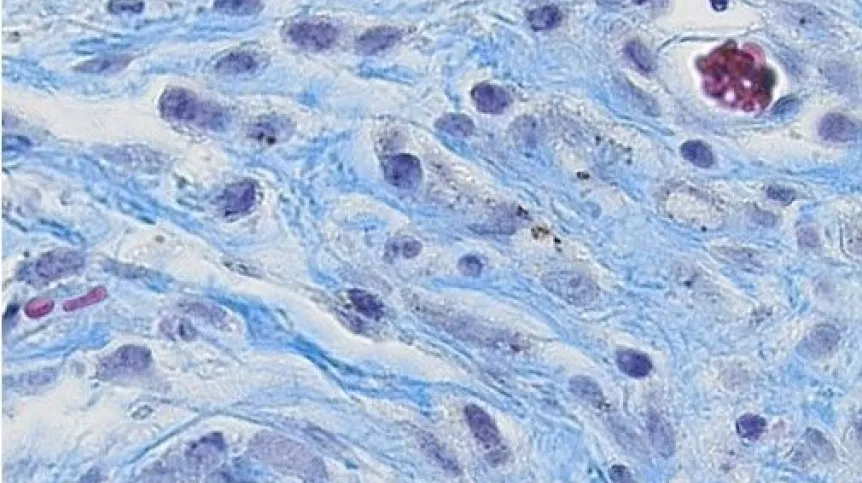
Scientists from Jagiellonian University have developed a new method of reconstructing soft tissue of the body's integumentary system in places where it is damaged.
The scientists say that it is ultimately intended to be an alternative to currently used methods based on fat tissue transplantation.
The invention has been tested in vivo. The solution was developed by an interdisciplinary team of scientists and students from the Faculty of Medicine of the Jagiellonian University Medical College and the Faculty of Biochemistry, Biophysics and Biotechnology of the Jagiellonian University, led by Dr. Marcin Piejko from the 3rd Department of General Surgery at the Jagiellonian University Medical College, reports Marek Massalski from the Jagiellonian University Centre for Technology Transfer CITTRU.
The new method is based on the method of processing adipose tissue of any donor, and then transplanting the resulting preparation into the place of tissue damage. This preparation - called adipoECM by the authors - is treated by the body as a scaffold, which is inhabited by the patient's own cells, including blood vessels.
The starting point for obtaining such a scaffold is adipose tissue, which can come from any (healthy) donor, for example after liposuction. Such material is subjected to the process of decellularisation, i.e. eliminating donor cells from the extracellular matrix.
Dr. Piejko says: 'What is important to us are the basic building blocks of tissue, which are commonly found in adipose tissue in each body. However, we need to remove all living and dead cells, as well as carriers of the genetic code - not only the ones originating from the donor, but also any bacteria or viruses that could be found in the starting material. Implantation of such compounds into a recipient's body could cause a strong immune reaction. The body would certainly not accept such material as friendly and suitable for colonization with its cells.’
The scientist emphasises that one of the main elements of the discovery is the method of obtaining adipoECM, i.e. the development of the processes of fat purification from undesirable compounds that are identified by the recipient's body as foreign factors (antigens). When such compounds are introduced into the body, cascades of defence reactions are triggered, which ultimately lead to transplant rejection.
'We know that adipose tissue in every human being is built by a certain universal group of compounds and proteins, common to our entire species. Looking for solutions to develop such a scaffold that would be accepted by any human body, we wanted to effectively remove everything that is not universal from the starting material. This is how adipoECM was created, a completely natural preparation that is potentially suitable for transplantation in virtually any person,’ says Dr. Piejko. He adds that this preparation is the extracellular matrix, which contains different types of collagen, elastin, fibrillin, fibronectin, tenascin and laminin.
The invention was tested in vivo in mice. Studies have shown that the adipoECM implantation site undergoes complete reconstruction of the connective tissue within 60 days, and the mice that had been operated on did not show any inflammatory reactions. This means that the implanted extracellular matrix was identified by the animals as a space suitable for cell colonization. Live cells and blood vessels were created in it only with the participation of the natural forces of the recipient's body.
The scientists emphasise that one of the main advantages of the method they have developed is the ability to perform minimally invasive tissue reconstruction procedures; another important aspect is a high degree of control over how the body regenerates the defect on its own, growing into the implanted scaffolding.
The next step will be clinical trials. 'We still have a long way to go because clinical trials are an expensive process that can take several years. However, the technology has a lot of key advantages over the currently used methods of tissue regeneration, so I am convinced that we will soon establish cooperation with the appropriate entity and introduce this preparation to the market as soon as possible', emphasised Dr. Gabriela Konopka-Cupiał, director of CITTRU UJ.
The research was carried out by an interdisciplinary team of scientists and students from the Faculty of Medicine of the Jagiellonian University Medical College and the Faculty of Biochemistry, Biophysics and Biotechnology of the Jagiellonian University - biochemists (Professor Paweł Mak, Elwira Ligas), cell biologists (Professor Justyna Drukała, Dr. Alicja Hinz) and doctors (Professor Piotr Wałęga, Dr. Marcin Piejko). The originator and leader of the project is Dr. Marcin Piejko (a medical doctor and biotechnologist). (PAP)
akp/ agt/ kap/
tr. RL













